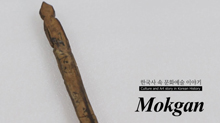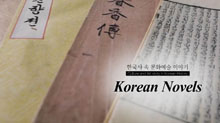The Story of Culture and Arts
- Image resource of Korean history
- Documents from History TextBooks
- Culture & Art Stories from Korean History
- Culture & Art Stories from Korean History - Korean
- National Institute of Korean History
- History net
- About the site
- Introduce
-
Numerous topics related to Korean culture and art are mentioned in middle and high school national history textbooks, but most of them are briefly described by era, making it difficult to understand their concepts, transition processes, and characteristics.
<Culture & Art Stories from Korean History> produces and provides video materials based on expert commentary on the flow, change process, characteristics and characteristics of each major topic in the field of culture and art in Korean history.

Scenario
Those stories sound made up, you say? They’re actually all real events from the Joseon Dynasty.
A domesticated elephant … killed two people. But according to the law, if a person is killed, the killer must also be killed. (…) It was requested that the elephant be sent to an island in Jeolla Province. - Taejong sillok (Veritable Records of King Taejong), Year 13 of King Taejong (1413), Month 11, Day 5
I brought an extraordinary, unearthly warrior whose face was unique, and I will let him be seen. (…) He was called the ‘sea ghost.’ His eyes were yellow, his face was black, so too were his limbs and body. - Seonjo sillok (Veritable Records of King Seonjo), Year 31 of King Seonjo (1598), Month 5, Day 26
These are official accounts from the state annals called the Veritable Records of the Joseon Dynasty. Records that can teleport us back to the Joseon period!
Why are the Veritable Records of the Joseon Dynasty considered today one of the greatest memories of the world?
Veritable Records of the Joseon Dynasty, Records even the King Couldn’t See
The Veritable Records of the Joseon Dynasty are the official state records of the Joseon Dynasty, chronicling 472 years of historical events from King Taejo to King Cheoljong by year.
Currently, there are 1,707 volumes in 1,187 books. Quite the wealth of knowledge!
A troopship from Jeju Island sank during a typhoon. It was escorting a royal commissioner. - Taejong sillok (Veritable Records of King Taejong), Year 13 of King Taejong (1413), Month 10, Day 18
Its contents covered a wealth of topics, from politics, economics, and the military, to geography, music, and natural disasters. The records were meant to pass on the history of the Joseon Dynasty to later generations. So who wrote them, and how?
When looking at a painting of King Yeongjo’s wedding, we see the word “sagwan” written behind his palanquin. Sagwan, or chroniclers, were not only present at ceremonies but regularly followed the king, noting his and his subjects’ every word and action. These notes are called sacho.
Sacho were assembled once a year into the sijeonggi or administrative record. In the sijeonggi, the main contents of sacho and the work logs for each ministry were summarized. Only the most important documents were compiled into the Veritable Records..
In that case, when were the Veritable Records finally compiled? After a king dies, a temporary committee called the “Sillokcheong” or Office of Annals, is set up. Veritable Records took several years to compile. And they could not be read or modified, even by the king himself. After compiling the Veritable Records, every sacho used had to be destroyed.
Secho is a method of soaking paper in water to make a document’s text illegible. Why was such a thing done?
Currently, Kim Ilson has strayed from his duty and written outrageous things regarding the work of the previous king while also citing the “Lament for Emperor Yi of Chu” by his master (Kim) Jong-jik. - Yeonsangun ilgi (Diary of King Yeonsangun), Year 4 of King Yeonsangun (1498), Month 7, Day 17
There were a few instances of gajang sacho, private notes kept at a sagwan’s residence, criticizing the king or his subjects. These leaked sacho caused great conflicts between political factions. The First Literati Purge during the reign of King Yeonsangun was based on leaked sacho.
Preventing the leaking of sacho or completed Veritable Records was of the utmost importance as it ensured objective writing by the sagwan.
“The most important aspect of historical documentation is its faithful retelling of an event. That is why, to ensure impartial writing, access to sacho was heavily controlled. Not even the king or high-ranking officials could see them or the Veritable Records. This helped sagwan record events objectively and away from the watchful eyes of those in power.” Kang Moonshik, Professor / Soongsil University, Dept. of History
The chronicler’s drafts (sacho) are to record the right and wrong of the sovereign, the wisdom and folly of high officials, and the good and evil of political affairs of the time. - Sejong sillok (Veritable Records of King Sejong), Year 14 of King Sejong (1432), Month 5, Day 17
Although rare, there were times when the records could be viewed to reference a previous incident. If the relevant text was deemed problematic, a revised record, or sujeong sillok, was compiled.
However, both the original and revised records were kept. This is so later generations could identify the original record’s problems and justify the revised edition’s changes.
Kings and officials feared criticism of their work would be passed on. These policies kept the ruling class from abusing their power and encouraged them to practice honest politics.
Another reason the rule of objective writing was protected was in the hope that later generations would reflect on the writings and govern righteously.
Veritable Records of the Joseon Dynasty, Protected for Future Generations
In the early Joseon period, Veritable Records were kept in four archival repositories: the Chunchugwan, Chungju, Jeonju, and Seongju. But during the Imjin War, the Japanese army destroyed three repositories in their advance, while the Jeonju Repository was in crisis.
“With Jeolla-do Province Governor at the helm, they discussed how to safely evacuate the Veritable Records from the repository and the portrait of King Taejo (from Gyeonggijeon Shrine). The official in charge of Gyeonggijeon, Oh Huigil, decided they should be moved to Naejangsan Mountain. Upon hearing this, Confucian students Ahn Ui and Son Hongrok financed the transfer of the records and joined in the move.”
Ahn Ui and Son Hongrok hurriedly moved the Veritable Records to Naejangsan Mountain for safe keeping. Imgye gisa by Ahn Ui records how these two men faced rain, wind, and snow and spent 370 days on night watch in the mountains.
The records can be seen today because these men protected the Jeonju copies with their lives. Following the Imjin War, four additional copies were printed using the Jeonju repository copy. To prevent this incident from reoccurring, the records were moved to treacherous mountainsides or islands.
How had the Veritable Records been cared for? The records, which are kept in a chest, are pulled out of storage every 2-3 years for routine airing. This prevents moisture and bug infiltration.
A record is made each time the Veritable Records leave or are returned to storage. This record is called the Hyeongjian.
The Hyeongjian is very detailed, providing the status of the collection and which sagwan was sent. As you can see, the management of the Veritable Records is very strict.
Even in modern times, the Veritable Records were kept safe, such as during the Japanese Occupation and the Korean War. As their sheer numbers attest, the Sillok are the product of an ardent commitment to future generations.
Though other East Asian countries also have annals, the Veritable Records of the Joseon Dynasty are considered unrivaled and were designated a UNESCO Memory of the World.
“China’s Veritable Records tell the story of the Ming and Qing Dynasties. But one should note that Emperors could read these records, and parts of the records were rewritten when those in power changed. Because of this, I can say that the Veritable Records of the Joseon Dynasty constitute a more superb and valuable archival record.” Kang Moonshik, Professor / Soongsil University, Dept. of History
The Veritable Records of the Joseon Dynasty are now available for reading online. The Veritable Records of the Joseon Dynasty will be remembered as living history as well as a magnificent set of historical records that has inspired untold readers.
[Epilogue]
Must-Know Facts on Culture and Art in Korean History
1. The Veritable Records of the Joseon Dynasty are an annual chronicle of the 472 years of history, from King Taejo to King Cheoljong.
2. Sacho are records by a sagwan of the king and his subjects’ words and actions.
3. During the Imjin War, several people risked their lives to save the Jeonju Repository copy of the Sillok.





